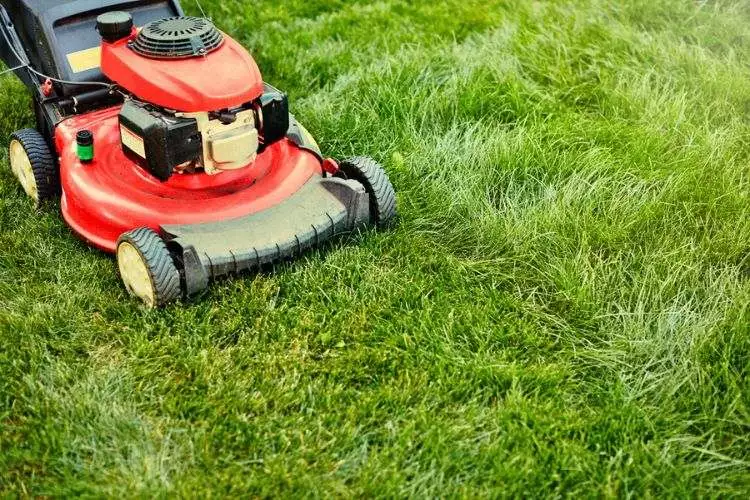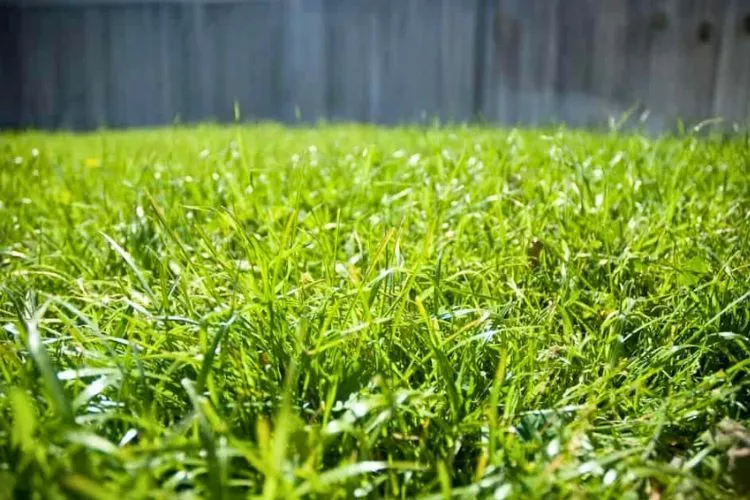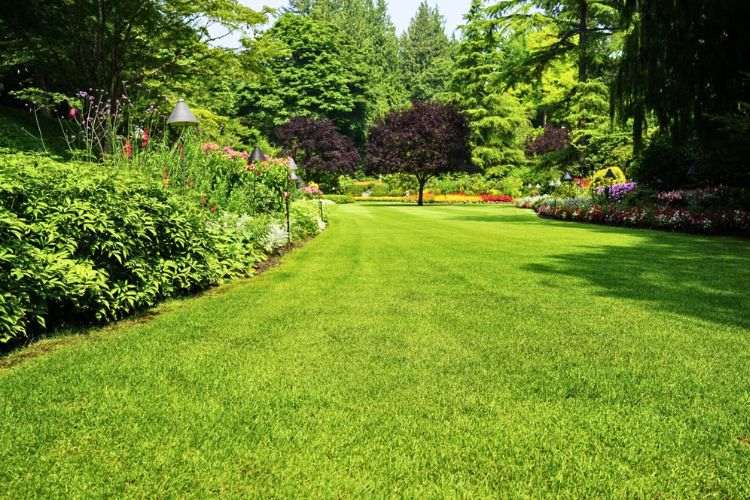Here aim to break down the factors affecting grass growth and comprehensively analyze post-mowing circumstances. Packed with science-driven insights, practical advice. Stay tuned till the end; the potential speed of the rebirth of your lawn might just surprise you. Let’s find out, how fast does grass grow after mowing?

How fast does grass grow after mowing?
The exact rate of grass growth after mowing may vary significantly based on numerous factors such as species, the overall health of the lawn, soil conditions, and weather. Generally, most lawn grasses grow at about 2 to 6 inches per month or roughly 0.05 to 0.20 inches per day. After mowing, given optimal conditions with sufficient water and nutrients, you can expect your grass to start showing noticeable growth within a week or so. It’s important to note that controlled care and attention are essential to maintain a healthy growth rate and ensure lawn longevity.
Does grass grow faster if you mow it?
Yes, grass tends to grow faster when you mow it. When grass is cut, the leaf area utilized for photosynthesis reduces, and the plant maximizes its efforts to regrow the lost volume as quickly as possible. Additionally, the tips of each grass blade contain hormones that suppress horizontal growth, so mowing helps make your grass grow thicker, allowing the grass to spread when you cut it. However, no scientific evidence shows that lawn mowing makes it grow significantly faster. To ensure the health and quality of your lawn, it’s crucial to consider other factors like proper watering, fertilization, and regular maintenance.
What makes grass grow faster?
Various factors can influence grass growth. To help your lawn reach its full potential, here are some key elements to consider, separated into subheadings for easy reference.

Soil Quality
- Nutrient-rich soil: Providing a nutrient-rich environment is essential for grass growth. Establish a balanced soil composition, with nitrogen, phosphorus, and potassium frequently present. Soil testing can help determine the nutrient levels and pH balance required for your lawn.
- Soil aeration: Compacted soil hinders grass growth by inhibiting root penetration and the absorption of essential nutrients. Aerate your lawn regularly to improve access to oxygen, water, and nutrients.
Watering
Consistent watering: The grass thrives better with consistent watering that promotes a deeper root system. Water the lawn early in the morning to minimize evaporation. Aim for 1 to 1.5 inches of water per week, including rainfall, adjusting according to weather conditions and grass type.
Fertilization
Appropriate fertilization: Proper fertilization encourages faster grass growth. Apply fertilizer according to the grass species and the soil test results. Organic fertilizers like compost and manure gradually release nutrients and improve soil structure.
Mowing
- Correct mowing height: Maintain the appropriate mowing height for your grass type. Cutting too short may expose the grass to stress, while cutting too high may result in weaker growth.
- Sharp mower blades: Dull mower blades tear the grass instead of making a clean cut, potentially causing damage that hinders growth. Regularly sharpen or replace your mower blades to ensure a precise cut.
Grass Type
Species selection: Choose native grass species that thrive in your region’s climate and soil conditions. Locally adapted varieties will grow faster and healthier than non-native species.
Does rain make grass grow faster?
Yes, rain does make grass grow faster. Rainwater provides ideal hydration for grass and can also be a considerable source of nutrients for your lawn]. It has been found that rainwater may have a better pH necessary for grass growth. Specifically, during a rainstorm, lightning can cause nitrogen to combine with hydrogen, resulting in a natural fertilizer that enriches the soil. However, it’s important to consider that overwatering grass might lead to detrimental effects, such as turning the grass brown or yellow.
Does grass grow faster in sun or shade?
Grass generally grows faster in sunlight than in the shade. Most types of grass require at least six hours of sunlight each day for optimal growth. Grass in shade areas may have slower growth rates and thinner appearance due to the limited access to the sunlight it needs for photosynthesis. Some grass species, like Kentucky Bluegrass, are designed to tolerate shade to some extent, but they still grow better in sunnier conditions.

However, specialised shade-tolerant grasses can be used for lawns with limited sunlight. These grasses may not grow as quickly as their counterparts in full sun, but their growth rate in the shade is much better than grasses that are not shade-tolerant.
Grass typically grows faster in the sun than in the shade, but selecting the right grass species and ensuring proper care can help optimize growth in shaded areas.
What not to do when growing grass?
To ensure a healthy lawn, avoiding certain mistakes when growing grass is important. Here are the things you should not do, broken down into subheadings for easy reference.
Watering Mistakes
- Overwatering: Too much water can suffocate the roots and lead to diseases. Stick to the recommended watering amount of 1 to 1.5 inches per week, adjusting according to weather conditions and grass type.
- Inconsistent watering can lead to shallow root systems and weak grass. Water your lawn deeply and infrequently rather than with daily light watering.
- Wrong time of day: Watering during the day can lead to increased evaporation. Early morning is the best time to water your lawn to minimize evaporation and avoid fungal infections.
Watering Fertilization Mistakes
- Under-fertilization: Insufficient nutrients will hinder grass growth. Depending on the grass species and soil conditions, ensure proper fertilization to encourage vibrant and healthy growth.
- Over-fertilization: Too much fertilizer can burn your grass and damage the soil. Conduct a soil test to determine the accurate nutrient quantities and ratio required for your lawn.
Mowing Mistakes
- Cutting too short (scalping): Mowing grass too short may result in weak growth and increased vulnerability to diseases and pests. Maintain the appropriate mowing height for your grass type.
- Not sharpening mower blades: Dull mower blades can tear the grass instead of providing a clean cut, thereby causing injuries to the grass. Regularly sharpen your mower blades for precise cutting.
- Mowing wet grass: Mowing wet grass can create an uneven cut and spread fungal diseases. Wait until the grass has dried before mowing.
Seed and Soil Mistakes
- Planting the wrong grass type: Not all grass types suit every region. Choose a grass species that thrive in your local climate and soil conditions.
- Ignoring soil conditions: Soil testing is essential in determining nutrient levels, pH balance, and composition. Ignoring soil conditions can lead to stunted growth or weed infestations.
- Overseeding: Avoid spreading seeds too densely, as overcrowding can lead to resource competition and poor growth.
frequently asked questions (fAQs)
How fast does grass grow in a week?
Grass growth rate varies significantly depending on the type of grass, weather conditions, and care provided. Generally, most lawn grasses grow at a rate of about 2 to 6 inches per month, which equates to roughly 0.5 to 1.5 inches per week.
How fast does grass grow per day?
On average, grass grows at a rate of 2 to 6 inches per month. Breaking this down to a daily rate equals approximately 0.07 to 0.2 inches per day. However, growth may fluctuate due to various factors such as grass type, weather, and soil conditions.
Does frequent mowing thicken grass?
Yes, frequent mowing can thicken grass. Mowing stimulates lateral growth and encourages the grass to grow densely. However, don’t cut the grass too short, as it might stress and hinder its overall health. Maintaining an appropriate height, depending on the grass type, is essential.
Conclusion:
how fast does grass grow after mowing varies depending on grass species, weather conditions, soil quality, and proper lawn care practices. While grass type and regional climate play a significant role, adhering to appropriate mowing heights, water sufficiently, and maintaining soil health for optimal growth is crucial.
Remember that mowing frequency and maintaining sharp mower blades also contribute to a lush, thick, and healthy lawn. By understanding the intricacies of grass growth and applying these insights to lawn care routines, homeowners can effectively maintain a vibrant and thriving lawn all year round.
